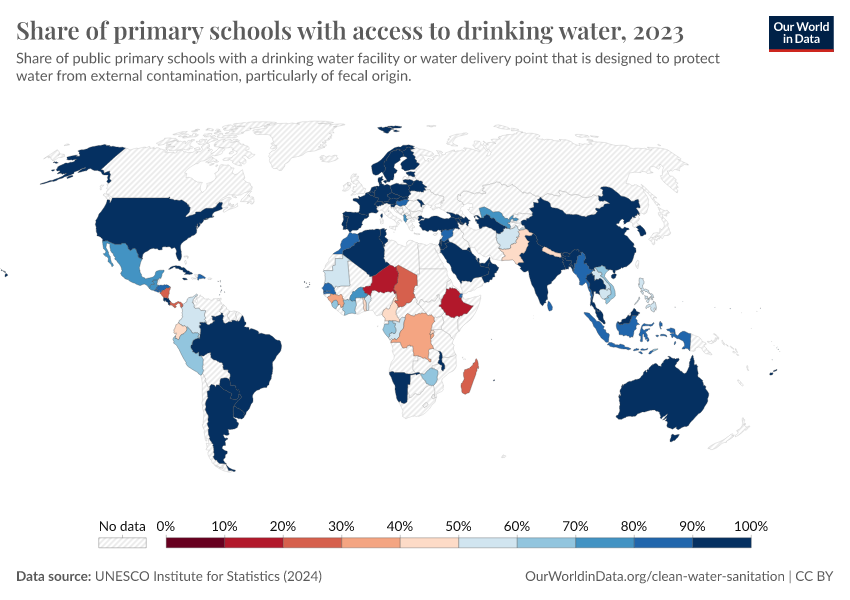Share of primary schools with access to drinking water

What you should know about this indicator
- Safe drinking water is essential for a healthy learning environment — this indicator shows how many primary schools provide students with access to clean water.
- It measures the percentage of primary schools that have access to basic drinking water services, meaning water from an improved source that is available on school grounds or within a short walking distance.
- Improved sources include piped water, boreholes, protected wells or springs, rainwater, or packaged/tank water that meets national safety standards.
- A high value reflects adequate infrastructure for supporting health, hygiene, and student well-being, which are essential for school participation and performance.
- The data is typically collected through school censuses or education management information systems (EMIS) and is reported by school administrators or district education offices.
- This indicator can be disaggregated by location (urban/rural), public/private management, or region to identify equity gaps in access to basic services across schools.
- In some contexts, data may rely on school-reported access, without verifying water quality or availability throughout the year.
- While access alone does not guarantee regular availability or safety, this measure is a key starting point for understanding school readiness to support children’s health and learning needs.
What you should know about this indicator
- Safe drinking water is essential for a healthy learning environment — this indicator shows how many primary schools provide students with access to clean water.
- It measures the percentage of primary schools that have access to basic drinking water services, meaning water from an improved source that is available on school grounds or within a short walking distance.
- Improved sources include piped water, boreholes, protected wells or springs, rainwater, or packaged/tank water that meets national safety standards.
- A high value reflects adequate infrastructure for supporting health, hygiene, and student well-being, which are essential for school participation and performance.
- The data is typically collected through school censuses or education management information systems (EMIS) and is reported by school administrators or district education offices.
- This indicator can be disaggregated by location (urban/rural), public/private management, or region to identify equity gaps in access to basic services across schools.
- In some contexts, data may rely on school-reported access, without verifying water quality or availability throughout the year.
- While access alone does not guarantee regular availability or safety, this measure is a key starting point for understanding school readiness to support children’s health and learning needs.
Sources and processing
This data is based on the following sources
How we process data at Our World in Data
All data and visualizations on Our World in Data rely on data sourced from one or several original data providers. Preparing this original data involves several processing steps. Depending on the data, this can include standardizing country names and world region definitions, converting units, calculating derived indicators such as per capita measures, as well as adding or adapting metadata such as the name or the description given to an indicator.
At the link below you can find a detailed description of the structure of our data pipeline, including links to all the code used to prepare data across Our World in Data.
Reuse this work
- All data produced by third-party providers and made available by Our World in Data are subject to the license terms from the original providers. Our work would not be possible without the data providers we rely on, so we ask you to always cite them appropriately (see below). This is crucial to allow data providers to continue doing their work, enhancing, maintaining and updating valuable data.
- All data, visualizations, and code produced by Our World in Data are completely open access under the Creative Commons BY license. You have the permission to use, distribute, and reproduce these in any medium, provided the source and authors are credited.
Citations
How to cite this page
To cite this page overall, including any descriptions, FAQs or explanations of the data authored by Our World in Data, please use the following citation:
“Data Page: Share of primary schools with access to drinking water”, part of the following publication: Hannah Ritchie, Veronika Samborska, Esteban Ortiz-Ospina, and Max Roser (2023) - “Global Education”. Data adapted from UNESCO Institute for Statistics. Retrieved from https://archive.ourworldindata.org/20250909-093708/grapher/percentage-of-primary-schools-with-access-to-potable-water.html [online resource] (archived on September 9, 2025).How to cite this data
In-line citationIf you have limited space (e.g. in data visualizations), you can use this abbreviated in-line citation:
UNESCO Institute for Statistics (2025) – with minor processing by Our World in DataFull citation
UNESCO Institute for Statistics (2025) – with minor processing by Our World in Data. “Share of primary schools with access to drinking water” [dataset]. UNESCO Institute for Statistics, “UNESCO Institute for Statistics (UIS) - Education” [original data]. Retrieved January 9, 2026 from https://archive.ourworldindata.org/20250909-093708/grapher/percentage-of-primary-schools-with-access-to-potable-water.html (archived on September 9, 2025).